Do you want to learn about the different types of wasps in Ohio?
Finding the resources to learn about the different types of wasps in Ohio wasn’t as easy thing as I thought. Some resources didn’t have enough information, some were inaccurate, and others just were relevant.
That is why I created this post about 8 Common Types of Wasps in Ohio.
In this article, you will learn about the different types of wasps, their characteristics and behaviors, their role in ecosystems, and whether they are harmful to humans or not.
8 Types of Wasps in Ohio
#1. Bald-Faced Hornet (Dolichovespula maculata)
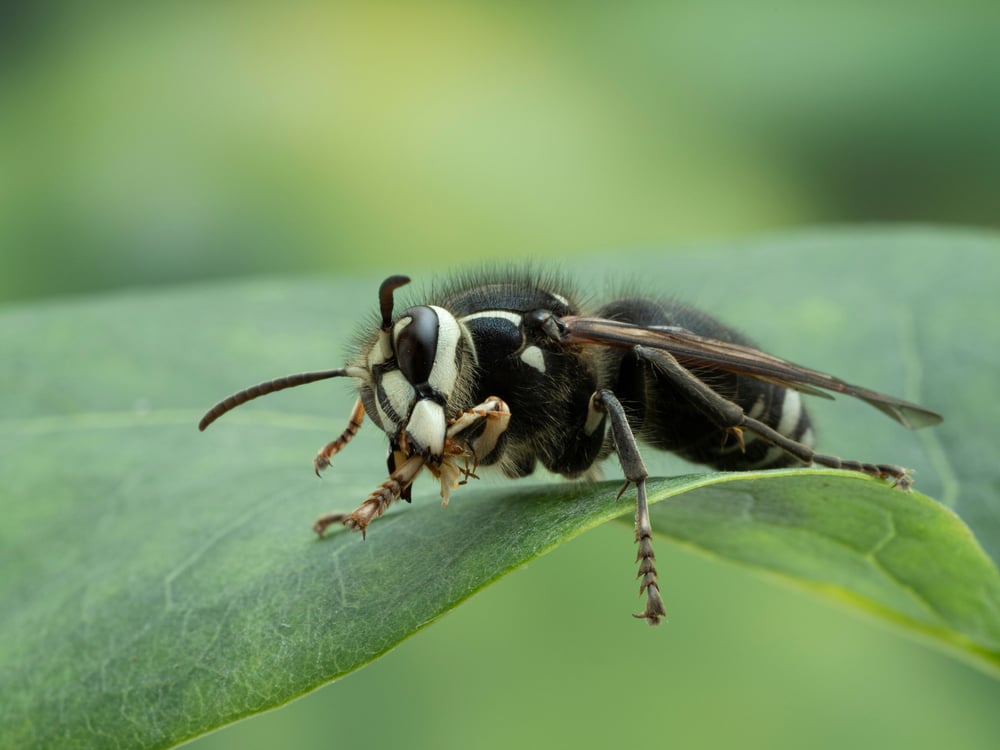
Identifying Characteristics and Facts
- Body length of about 1.5 – 2.0 inches.
- White thorax and face and with a black abdomen.
- Wings coloration is smoky gray.
- Can deliver painful sting when threatened.
- Social and thus live in colonies.
- Usually active from late spring through to early fall.
The bald-faced hornet is one of the wasp species common in Ohio. This species is also widespread in most other regions of the world.
One thing you will learn about these wasps is their social nature. You will find them in colonies composed of up to over 700 individual wasps.
In the colony, you will find the queen being responsible for reproduction, and the workers responsible for other roles such as foraging for their food.
When it comes to habitats, Bald-faced hornet usually build their nests under caves, in trees, and in the bushes.
Though this species can bite, it is only when they feel threatened. You should note that Bald-faced hornet wasps are not aggressive like some other insects but they can only sting when provoked.
Not only that, but these wasps are important since they help control the pest’s populations.
#2. European Paper Wasp (Polistes dominula)
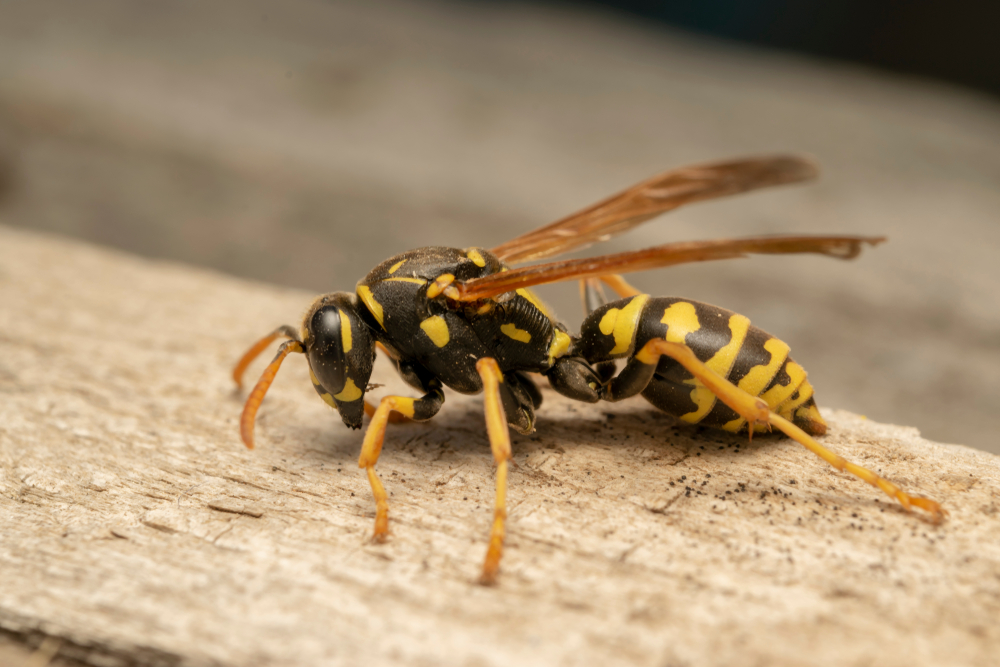
Identifying Characteristics and Facts
- Not aggressive but they can sting when provoked.
- They are about 1 inch long with the same wingspan size.
- They construct their nests using paper.
- Social and stays in colonies of about 50 individual wasps with a single queen.
- Omnivores usually eat insects, pollen and nectar, caterpillars, and spiders.
- Their sting is not fatal.
This social wasp is widespread in many parts of the world. It is also a common type of wasp in Ohio. Being social, they live in colonies with individuals of up to 50 or more.
The size and coloration of these wasps vary due to gender and age. For instance, you will find that the males are smaller in size than the females and the queen is the largest. Also, the workers and the queen are more yellow than the males.
When it comes to feeding, these wasps obtain their food from various sources. They eat insects, nectar and pollen, and spiders just to mention a few.
#3. Eastern Yellowjacket (Vespula maculifrons)
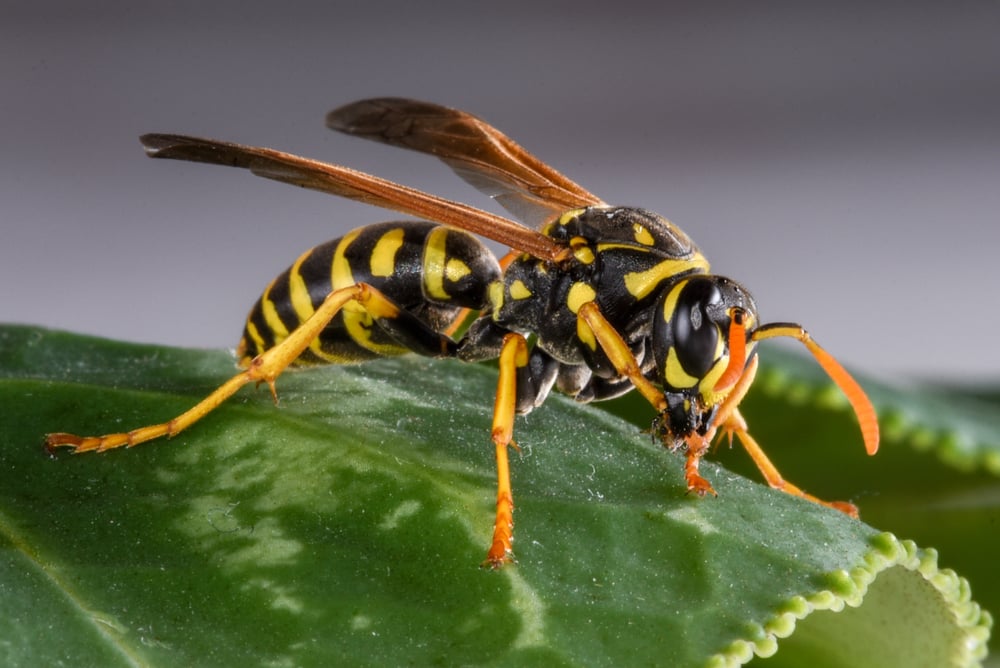
Identifying Characteristics and Facts
- Usually attracted to sweet smells.
- Aggressive and they can sting when they feel threatened.
- They have painful stings but they are not fatal.
- Live in colonies that comprise up to 5,000 individual wasps.
- Has a black body with some yellow markings.
- They are about ½ inches in body size.
This is a medium-sized wasp that is a common type of wasp in Ohio and also present in most other states. The Eastern yellowjacket is a beneficial insect that helps in controlling the populations of insects that could otherwise be harmful.
Though these wasps can be helpful, they can also be a great nuisance especially when they build their nests next to homes.
If you find their nests next to your home, it would be better to leave them or remove them with the help of a professional since they can easily sting when they are disturbed.
One other thing that is important for your knowledge about the yellowjacket wasps is their reproduction. It is worth noting that in each colony, there is a queen and also the workers. The queen is the one responsible for laying eggs, and the workers feed the larvae after they are hatched.
It is also important to note that the colony dies in the fall but the wasps usually survive and they start a new colony during the spring.
#4. Cicada Killers (Sphecius speciosus)
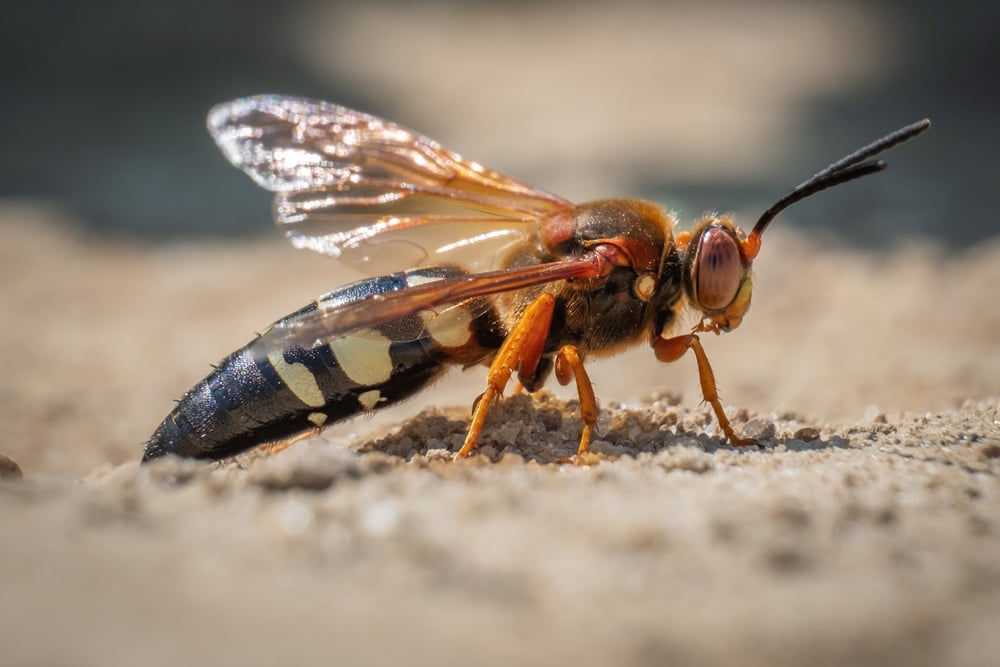
Identifying Characteristics and Facts
- Mostly active in summer.
- Prefer to stay in open areas with some sandy soil.
- They eat cicadas and are attracted to flowers and trees.
- Females live in their nests where they raise their young ones.
- They are not social and hence live solitary lives.
- Males are about 1.5 inches while females are larger and about 2 inches.
- They have black bodies with yellow markings.
These are large but solitary wasps that you will find in different parts of the world. They are also one of the common types of wasps in Ohio.
One thing to note about these wasps is their solitary nature. You will not find them in colonies like most other wasps. Also, if you want to spot them, they are usually active during the summer months.
Another characteristic that you can use to identify these wasps is their behavior. They, unlike other wasps, prefer to stay or live in areas that have some sandy soil. In addition to that, they are attracted to trees and flowers where they are likely to find cicadas.
As mentioned above, they usually feed on cicadas. When it comes to nesting, these wasps as also noted are solitary and each female wasp will build her own nest where they can raise their young ones.
#5. Great Golden Digger Wasps (Sphex ichneumoneus)
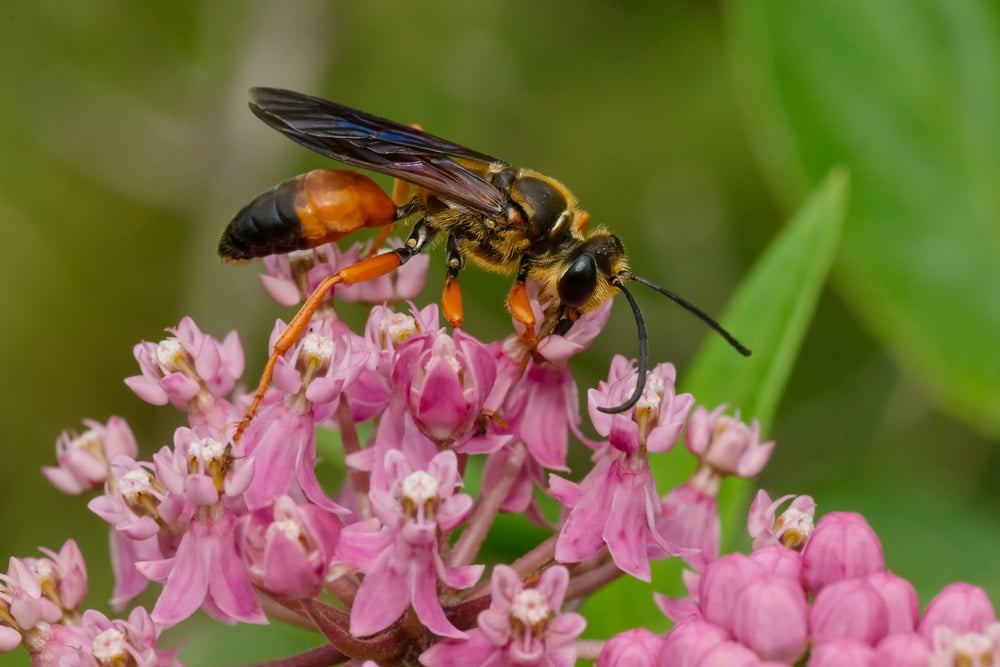
Identifying Characteristics and Facts
- About 0.6 – 1.1 inches in body length.
- Solitary and does not live in colonies.
- They eat insects such as grasshoppers and crickets.
- Females lay eggs then hatch in burrows in the ground.
- Helpful in controlling the populations of crickets and grasshoppers.
- Their nests are often in areas that have direct sunlight or in loose soil.
- They are not aggressive and may not sting humans unless they are provoked.
- Have black bodies with some bright golden-brown markings.
Great golden digger is also one of the common types of wasps that you can find in Ohio. It is a fairly large wasp and with some orange-red markings on a black body.
Just like the cicada killers, these wasps also live in solitary. That means they don’t live in colonies and aren’t social like some other wasps. The females also live in their own nests where they raise their young ones.
It is also great to understand that females usually live in burrows that they dig in the ground. They also use their sting to paralyze their prey including grasshoppers and crickets.
The females then take the paralyzed prey into their burrows where it lays eggs on it which in turn becomes the food for the larvae.
#6. Mud Dauber (Sceliphron caementarium)
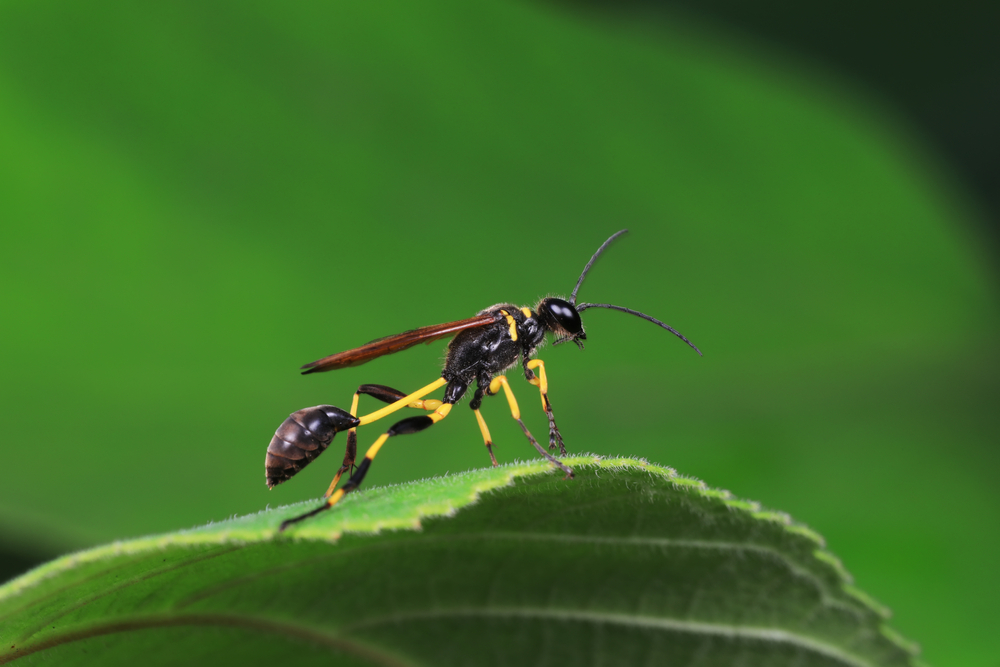
Identifying Characteristics and Facts
- About 0.5 to 1 inch in body length.
- They are solitary by nature and do not form colonies.
- Slender with black or brown coloration.
- They use clay or mud to build their nests that are tubular and elongated in shape.
- Live in a variety of habitats be it forests, gardens, or even urban environments.
- They hunt spiders and then paralyze them for food.
- Usually calm and not aggressive.
The mud dauber wasps are common in Ohio and well-distributed in many parts of the world. It is one of the wasps that you don’t have to fear as they are not aggressive toward humans.
These wasps are also solitary and hence you will not find them in colonies like some of the other social wasps do. Being not aggressive to humans, these wasps are thus beneficial and since they feed on sugary substances such as nectar and spiders, they help a lot in controlling their populations.
Another thing about these wasps that you should know is their habitat. They like to live in various habitats that have easy access to mud and flowers.
#7. Thread-Waisted Wasps (Ammophila spp.)
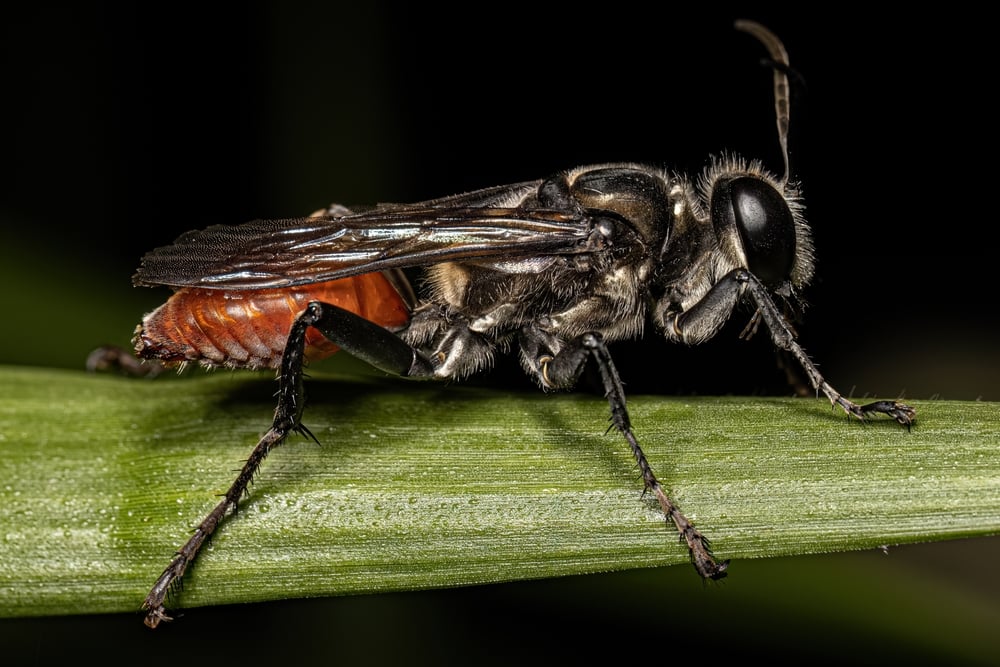
Identifying Characteristics and Facts
- About 0.5 – 2 inches in body size.
- They have a slender or thread-like waist.
- Their bodies are clearly differentiated into head, thorax, and abdomen.
- Usually have striking coloration of orange, yellow, brown, or black with green markings.
- Solitary and hence do not form colonies.
- They feed on caterpillars and nectar.
- They have a sting that they use to paralyze prey and protect their nests.
These wasps are well-known for hunting and nesting. And they are among the common types of wasps in Ohio but you will also see them in other parts of the world.
When it comes to their hunting, these wasps use their hunting skill to paralyze caterpillars and that is their primary source of their food. They nest underground where they build their nests with mud in loose or sandy soil.
As the name puts it, these wasps have a thread-like waist that makes them distinct from other wasps. In addition to that, you will also see a clearly segmented body with the head, thorax, and abdomen.
The other important thing to know about the Thread-Waisted Wasps is their sting, flight, and even habitat. Of course, they do have a sting that they use for paralyzing the prey and also for protecting their nests when they are threatened.
These wasps are agile flyers. You will see them hovering around places with flowers and shrubs in search of nectar and prey. Not only this, but you will find them mostly in gardens, meadows, fields, and woodlands among other habitats.
#8. Paper Wasps (Polistes spp.)
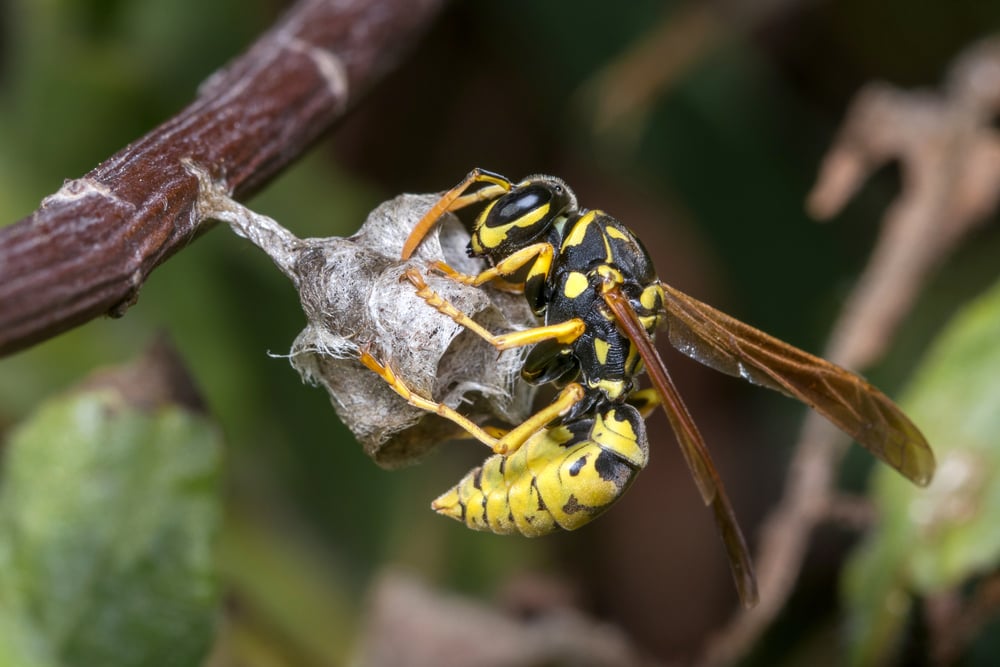
Identifying Characteristics and Facts
- About 0.5 – 1 inch in body length.
- They have varied colors but commonly are yellow, brown, or black.
- Have six legs and two pairs of wings.
- Social and thus form colonies.
- Less aggressive but can sting when disturbed.
- Builds paper-like nests in protected areas.
These wasps are common in most parts of the world and you will also find them in Ohio. Unlike other wasps that are solitary, paper wasps are social and hence they usually live in colonies.
As the name suggests, these wasps build their nests using paper-like material. They obtain the material by chewing wood fibers, then they mix them with their saliva. You will find these nests attached to some protected grounds such as walls, eaves, or tree branches.
When it comes to aggressiveness, these wasps are less aggressive than your average wasp. They can, however, sting if you disturb their nests. Their repeated stings are painful and you will feel some pain irritation and even swelling for a few hours.
As a reminder, the below factors are common for the most common types of wasps in Ohio:
- Size, wingspan, and color are common ways to identify wasps.
- Behavior and diet are ways to determine the type of wasps and its role in its environment
- Wasps can be beneficial flying insects. They can also be harmful to humans.
- Wasps, like other flying insects are facing numerous ecological challenges